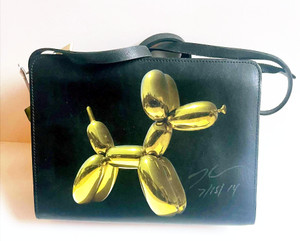
Jeff Koons, Lavishly illustrated 592 page monograph (hand signed by Jeff Koons), 2009
Jeff KoonsCONTACT GALLERY FOR PRICE
Jeff Koons
Lavishly illustrated 592 page monograph (hand signed by Jeff Koons), 2009
Hardback monograph with dust jacket (hand signed by Jeff Koons)
Boldly signed and dated 12/1/14 on the half title page
13 1/2 × 10 × 2 inches
Boldly signed and dated 12/1/14 by Jeff Koons on the half title page.
Signed for the present owner
Book information:
Publisher: TASCHEN, 2009
Hardcover, English, French and German, 592 pages with color illustrations
Publisher's blurb:
The definitive work on the most controversial artist of his generation: see the exhibition in Berlin and remember why you’ve always loved Koons, even though you’d love to hate him—he’s not only richer, but better looking. Then plunge into this Taschen überwerk and revel in the kinky and kitsch, but always conceptual art of Jeff Koons. Basketballs in tanks! Stainless steel blow-ups! Topiary dog sculptures! Michael and Bubbles in porcelain. No artist since Warhol has made the banal appear so profound, and the trivial carry such import.
Includes a biographical essay, analyis of Koons from a European perspective, and a scholarly study of his work. With hundreds of large format full color images, it traces Koons’ career from 1979 to today. A sumptuous objet d’art—he says so himself—and the definitive overview of Koons’ work.
About Jeff Koons:
I like to think that when you leave the room, the art leaves the room. Art is about your own possibilities as a human being. It’s about your own excitement, your own potential, and what you can become. It affirms your existence.
—Jeff Koons
Jeff Koons rose to prominence in the mid-1980s as part of a generation of artists exploring the meaning of art and spectacle in a media-saturated era. With his stated artistic intention to “communicate with the masses,” Koons makes use of conceptual constructs—including the ancient, the everyday, and the sublime—creating luxurious icons and elaborate tableaux, which, beneath their captivating exteriors, engage the viewer in a metaphysical dialogue with cultural history.
Born in York, Pennsylvania in 1955, Koons studied at the School of the Art Institute of Chicago and the Maryland Institute College of Art in Baltimore and, receiving a BFA from the latter in 1976. Since his first solo exhibition in 1980, his work has evolved from small-scale assemblages of toys and found objects to his now iconic monumental works, including huge balloon animals rendered in mirror-polished stainless steel, as well as flowering topiary sculptures, such as Puppy (1992), which is permanently installed at the Guggenheim Museum Bilbao.
Koons draws attention to the continuity of images as they pass through time, combining art historical reference with vernacular images and objects, from common suburban products and mass media to symbols of sexuality and transcendence. Beginning with Inflatables (1978–79), a series inspired by the readymade, Koons created six series of innovative works in less than a decade including Pre-New (1979–80), The New (1980–87), Equilibrium (1983–93), Luxury & Degradation (1986), and Statuary (1986). His interest in popular culture expanded in the Banality series (1988), which included sculptures of recognizable figures such as Michael Jackson and Bubbles (1988)—a nearly life-size gold-leaf porcelain statue of the pop singer with his pet chimpanzee. In 1989, Koons presented Made in Heaven (1989–91), a series centered on him and his then-wife in sexually explicit poses, frequently in fairytale settings, evoking the stark bodily presence of the nudes depicted by French Realist painters.
During the mid-1990s, Koons expanded his Pop sensibility through the Celebration series (1994–): hyperrealistic, brightly colored paintings and large-scale sculptures depicting vernacular images and forms such as plastic figurines, Play-Doh, and jewelry. Conflating the readymade and the monumental, these works attest to Koons’s ongoing fascination with childlike consciousness and communication; transforming humble objects into abstract symbols of transcendence and the biological. In 2000, seven new works by Koons debuted at the Deutsche Guggenheim: the Easyfun-Ethereal paintings. Derived from the optimistic, colorful Easyfun series (1999–2000), these layered, collage-like tableaux depict cut-out photographs of packaged foods, paradisiacal landscapes, and fragments of women’s faces, limbs, hair, clothing, and accessories. Attesting to Koons’s interest in the simple pleasures of visual culture, Easyfun-Ethereal would eventually be expanded to twenty-four paintings, presenting uncanny, imaginative panoramas.
Koons’s dialogue with the readymade and American pop culture continued in his Popeye (2002–13) and Hulk Elvis series (2004–), which incorporate large-scale inflatable characters, either alone or combined with other objects and images, creating playful, often discordant relationships. Starting in 2008, the Antiquity series highlights Koons interest in metaphysics, a line of inquiry that was central to the making of the Equilibrium works and that continues to evolve in his latest works in production.
Among Koons’s recent works is the Gazing Ball series (2012–), in which he makes direct reference to canonical works art. In each piece, a blue mirrored, hand-blown glass gazing ball reflects its surroundings, uniting painting, sculpture, and architecture in order to multiply sensory experience. Like much of his work, the Gazing Ball series reactivates and intensifies familiar scenes, whether from legend or the everyday, reflecting and affirming viewers and their environments.
Courtesy of Gagosian Gallery























